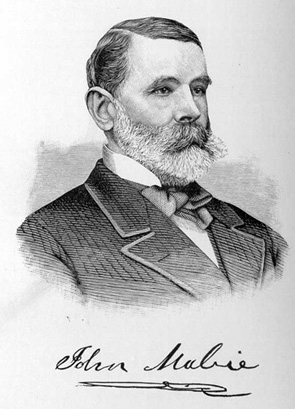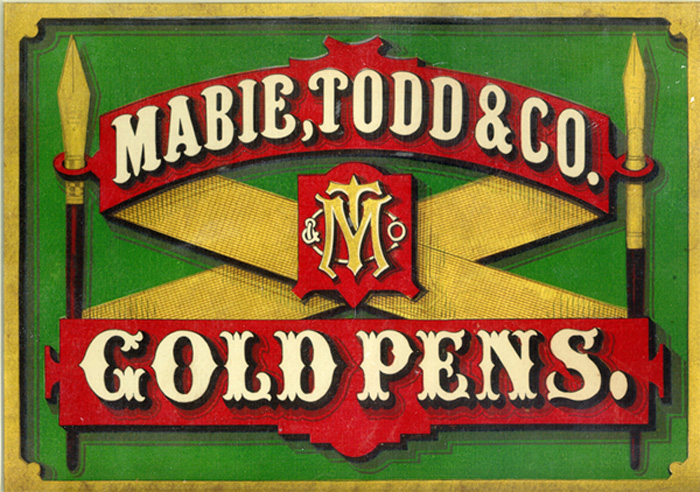|

Author David Moak presents what is arguably the most authoritative history
to date of this well known pen maker, the family of John Mabie, and their business
associations.
The history begins with a biographical sketch, published in 1882 stating that
John Mabie, born June 19, 1819, in New York City, entered the work force at the
age of nine, due to the death of his father…
This biographical documentary continues to weave the family history, mergers
and business events that reads like an exciting novel. What elevates this book
to more than a history of writing instruments, is the story of a 180 year adventure
of a family and their associations in writing instrument development.
The various ventures of the Mabie family are documented, from its first business
in 1843 to the closure of Mabie, Todd & Co. in 1941. The chapters discuss
the family beginnings with Rauch & Co., Bard Brothers & Co. and Smith
and Todd. Continuing with Mabie Knapp & Johnson, Mabie Knapp & McGovern,
Mabie Todd & Bard and Mabie Todd & Co. Many of these associations and
others are not common knowledge to today’s collectors, and are explained
with actual accompanying document reproductions found at museums, libraries and
private collections.

Cardboard advertising sign for Mabie,
Todd & Co. gold pens - 1860's
David Moak presents his research with a fascinating approach to the layout
of his material.
Far be it for this to be viewed as dry factual data, Mabie in America makes
for a very enjoyable read. With well placed actual document reproductions, patents
and contracts woven into the text and illustrated with detailed explanation of
events, personalities and consequences, this reader has found this compilation
a literary and visual treat.
Beautifully illustrated with over 280 detailed full color images of rare Mabie
Todd and Swan pens, many are actually full size or larger. This history will also
serve as a valuable reference source for collectors. Illustrated in detail are
pen barrel and cap imprints from the early 1854 Mabie pencils proceeding with
Mabie Todd & Co. dip pens and nibs, first generation Mabie, Todd and Bard
full overlay eyedroppers, Swan pens, Eternal and Fyne Point pencils.

Sterling eyedropper.
The vivid illustrations detail a progression of vintage ink bottles, pen boxes,
display advertising ephemera and print advertising. Arranged in chronological
order, this alone makes for a valuable reference.
Mr. Moak’s research uncovers little-known and surprising facts relative
to patent development. For example, “As far as lever-fillers, MT & Co.
didn’t exactly jump on the band wagon. It only took L.E. Waterman a year
to figure out a way around Sheaffer’s 1912 patent (by making a lever box).
Apparently, the first lever device used by MT & Co. was a compound lever system
patented in 1918 by Tagiro Tanimura, a Japanese citizen living in Wyoming. This
lever system required no spring.” The accompanying patents are also illustrated.
The research and development of this publication in itself is a remarkable
achievement. The author has shown by example of this work, that no matter the
level of one person’s knowledge or that of others in the field it may never
be sufficient to stand alone. If published material is to remain as a serious
and reliable reference source, patience, diligence and professional research efforts
are necessary. As David Moak states…”Usually the intent of pen books
has not been historical research, but general information for all pen collectors
on many makers. We have all benefited from these efforts. However, this book is
an attempt to move away from recording anecdotal oral history towards presenting
material that is fully documented. One reason this is possible is due to the narrower
scope of Mabie in America.”
The pens themselves are a valuable source of information and David was able
to benefit from examples offered by several collectors. David has chosen to complete
his own exhaustive research citing over thirty-five bibliographical sources, has
researched family histories and a multitude of sources listed in the very ample
accompanying Appendices, many complete with links for the reader’s further
inquiries. He has even gone to the extent of writing to every single Mabie family
name in various New York directories. Remarkably, this has resulted in contact
with great grand children of George Mabie, who have provided vintage photos and
records that are included in this documentary.
David further explains, “My first break was learning that there was
a contemporary biography of John Mabie. My second was locating a copy. That gave
me a history of sorts to check up on and the possible names of companies to check
out. Research proceeded from there.”
Worthy of mention is the clever and reader-friendly navigation of this material.
It’s obvious that a lot of thought went into designing a CD that is easy
to use.
I have found this documentary production to be most worthy and highly recommend
this as an addition to any pen library. For the serious collector a valuable resource.
For the novice or casual pen collector, this is an adventure story that will surely
inspire and motivation for further participation in the hobby.
Author David Moak is a classical guitarist and long-time collector of
Mabie, Todd (& Bard) pens and related items. He and his wife Mary Jane also
collect Dunn and Peter Pan brand pens. Any reader with an item or information
that he or she would like to share in the next edition is encouraged to contact
the author at info@mabie-todd.com. You
can order"Mabie in America - Writing Instruments from 1843-1941"
or get more information at www.mabie-todd.com.
The CD costs $30.
Text © 2003 Len Provisor Photos © 2003 David L.Moak.
|